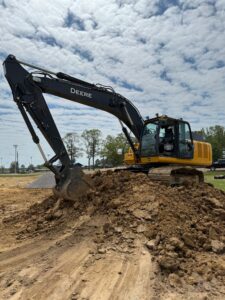Dirt work is the foundation of any successful construction project. It might not be the most glamorous aspect of construction, but it’s certainly one of the most crucial. Preparing a site for construction involves a series of detailed and essential steps to ensure the land is suitable for building. Here’s a closer look at what goes into this critical phase of construction, packed with engaging examples and surprising statistics.
Site Assessment and Planning
Before any physical work begins, thorough site assessment and planning are essential. This involves surveying the land to understand its topography, soil composition, and drainage patterns. For instance, a construction project in Texas revealed that nearly 80% of delays were due to inadequate site assessments. Proper planning can prevent such costly setbacks.
Clearing and Grubbing
Once the assessment is complete, the next step is clearing and grubbing. This involves removing trees, shrubs, and any other vegetation. In urban areas, this might also include demolishing existing structures. A fascinating example is the construction of the Hudson Yards in New York City, where clearing old train tracks and structures took months but was crucial for the project’s success.
Excavation
Excavation is where the heavy machinery comes in. Bulldozers, backhoes, and excavators are used to remove large amounts of soil and rock to create a level base for construction. This process can also include digging trenches for utilities and foundations. Did you know that the average construction project can move anywhere from 500 to 5,000 cubic yards of earth? To put that into perspective, that’s enough dirt to fill up to 400 dump trucks!
Grading and Compaction
Once excavation is complete, the next step is grading and compaction. Grading involves leveling the soil to ensure a flat surface, while compaction uses heavy rollers to compress the soil, providing a stable base. Proper compaction is crucial, as poorly compacted soil can lead to foundation issues. For example, in one study, nearly 25% of residential homes experienced foundation problems due to improper soil compaction.
Installing Utilities
With the site leveled and compacted, it’s time to install underground utilities. This includes water, sewer, electrical, and gas lines. In some projects, this phase can be particularly challenging. For instance, during the construction of the Channel Tunnel between the UK and France, engineers had to navigate complex underground utility installations under the seabed.
Erosion Control
Erosion control is an often-overlooked but vital part of dirt work. Techniques such as silt fencing, sediment basins, and erosion control blankets are used to prevent soil erosion and protect water quality. According to the EPA, effective erosion control can reduce sediment runoff by up to 90%, which is critical for maintaining environmental standards.
Final Preparation
The final step in preparing a construction site is ensuring everything is in place for the building phase to begin. This includes verifying the accuracy of the grading, ensuring all utilities are correctly installed, and implementing any necessary erosion control measures. For example, the construction of the Denver International Airport required meticulous final preparation, as the sheer scale of the project demanded flawless groundwork.
Conclusion
Dirt work might not be the most visible part of a construction project, but it’s the bedrock upon which everything else stands. From site assessment and clearing to excavation and erosion control, each step is crucial for a successful build. Next time you pass by a construction site, remember the extensive work that goes into preparing the ground beneath the structures. Investing in quality dirt work not only ensures the longevity of the project but also paves the way for a smoother construction process.





